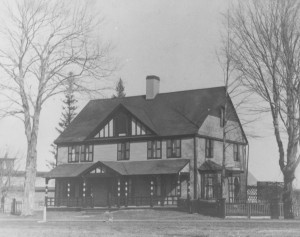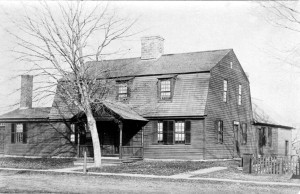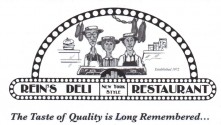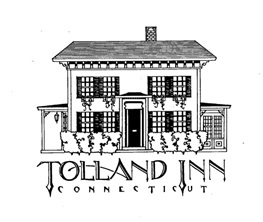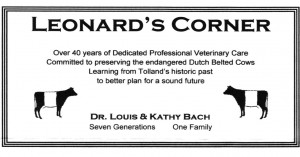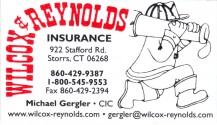Where Was Tolland’s Original Center Located?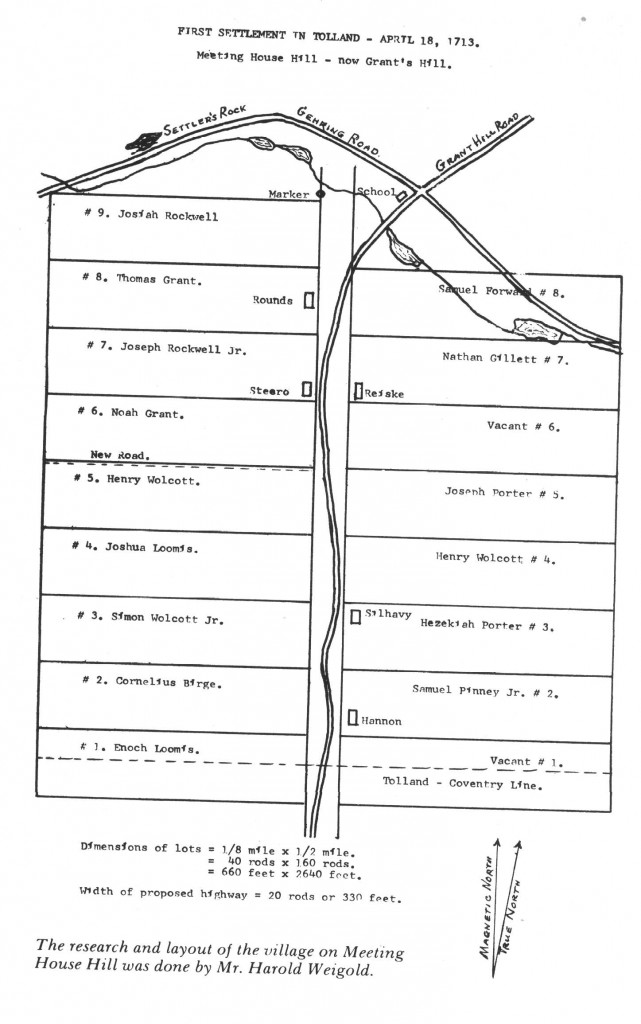
by Peter Palmer
The Town of Tolland is set to celebrate its 300th anniversary, having been set up as a town in 1715. A number of prominent men, mostly of Windsor, Connecticut, petitioned the Colonial Legislature for a new town. The patent was granted in 1715 for a town to be known as Tolland. It was to be six miles on a side, located on the west side of the Willimantic River. Coventry, incorporated in 1712, was its southerly abutting neighbor. The westerly and northerly boundaries were with common or undivided lands.
It seems straight forward enough to locate Tolland and its boundaries. Go to Coventry’s north corner on the Willimantic river, follow the boundary of Coventry west for six miles. Go north six miles to a point six miles west of the river, town, they laid out in the center of town, a highway over Meeting House Hill (Grant Hill Rd.) and granted to individuals, a furlong (1/8th of a mile each on the highway) of lots. A similar division was made on what is now Baxter Street.
A Burying Place, now the South Cemetery expected to be near the church, was established at the foot of Meeting House Hill. There are grave stones in the South Cemetery with dates before 1715.
Some believe that Tolland was once part of Windsor. Not so! The Petition for a new town “in the waste Lands of the Plantation of the Colony” was by a committee appointed by the Town of Windsor. When the Colonial legislature acted, fee title was granted to Matthew Allen, Roger Wolcott, Timothy Thrall and John Ellsworth, in trust. Ownership was in four trustees, not the Town of Windsor.
The west and north abutters were not specified but would have been on undivided or common lands, not Windsor. Bolton, including what later became Vernon, was incorporated in 1720 became one of our westerly abutters. In 1723 Windsor, in an involved reshaping of Suffield, Enfield and Windsor, received additional land easterly to Tolland (now the easterly part of Ellington) and between Tolland and Stafford to the WIllimantic River.
Francis West, one of the first settlers of Tolland built his house just south of ‘Tolland Center’. Just? The residents of Coventry had other ideas about where Coventry’s north line boundary was located and objected. Mr. Francis West was not a resident of Coventry. In 1713 you had to ask permission to be a resident and he had not asked. The disagreement was taken to the Colonial government. A survey was needed, commissioned and completed. It did not settle the matter and two more surveys were done.
The Colonial government in 1722, settled the disagreement simply by decreeing one survey to be the official boundary between the towns. The highway over Meeting House Hill was not in the center of town, as expected, but near the southerly boundary. While the argument over the town line raged, Tolland postponed building its first Meeting House/Church and Common until the boundaries of Tolland and its proper center could be located, a Meeting House Common established and the building constructed.
Locating this first Meeting House Common is a work in progress. Our earliest town history does not specify a location. A Meeting House Common would be established on land it already owned, so no deed or any description was needed. When the Town outgrew the location, finding one deed to an individual would be helpful, but so far none has been found. Deeds conveying parts of the Meeting House Common have been found. but the land can not as yet be reliably determined, and the present owners remain uncertain.
In 1749, to expand the Common and build a new Meeting House/church/School, the town did reacquire additional land. This deed is helpful but not definitive.Deeds by the proprietors of land abutting the Town Common, have been located, but the description of those boundaries are equivocal. Attempts to trace ownership of the properties forward to the present, thereby establishing the location, contain issues that have not been resolved.
Let us not forget Francis West and his house. In the end, it actually was in Coventry. He was supposed to be a resident of Tolland, living near the center and support Tolland not Coventry. So he had his house moved to Tolland. It is apparently the oldest part of the last house on the west side of Goose Lane, near the Coventry line.
Who Owned Property on Tolland Green
East Side, Part One by Peter Palmer
Until the location of the Tolland and Coventry boundary was settled in 1722 allowing the determination of the geometric center of Tolland, that area was not developed for a Town Green. By 1722, some property had already been granted to individuals, particularly Stephen Steel (often Steele), Tolland’s first minister. Determining just who owned what, where and when, involves lengthy title searching.
Starting on the southeast side of the green with number 26 Tolland Green, the first residence northerly of the present Old Post Road, its title and ownership runs backward to a ten acre parcel of land sold by Josiah Goodrich, a blacksmith, to John Huntington (Jr.), in 1750. The property was 17 Rods or 280.5 feet, (all distances will now be given in feet) on Town Street and 1,650 feet deep. It was bounded west on the Town Street, south, described first as a highway and second as a “path as now used”, east on Daniel Cook and north on Stephen Steel. The property included Joshua’s house. Whether it is the present house or a prior one is not certain from the records
Josiah Goodrich did not purchase any parcel of land just this size or shape, so it must have come from a larger parcel. In his first deed, from Rev. Steel in 1725, conveying two parcels, the first parcel is bounded northerly on Mr. Steel, easterly on Daniel Cook, south and west on highways and contains 60 acres. It has all the same abutters as the ten acre parcel, (the southerly boundary road was not Old Post Road), and may have included it.
Later, (March 1751), Josiah transferred to the Selectman of Tolland, (listing them individually), a 3 acre parcel for a highway, bounded northerly on land he sold to Huntington, (in 1750) and westerly on the highway. No width is given but the arithmetic indicates it was about 80 feet wide. John Huntington kept the ten acres until 1754 when he sold it to Elisha Steel, son of Stephen.
Elisha sold to Samuel Cobb in 1766, who gave it to his son, Samuel in 1769. Samuel Jr. sold it to Converse Cutter in 1782. He sold it in two parcels, the first to Elisha Baker, (22nd Feb. 1787), was 82.5 feet square at the northwest corner of the 10 acres. The remainder was sold (24th Feb 1787) to John Stearns of Massachusetts.
The Elisha Baker parcel is now 34 Tolland Green. The deed to him does not mention any structures, but his sale in 1788 to Jonathan Barnes, includes a house. Jonathan Barnes was one of the first lawyers in Tolland. He acquired additional land from the Stearns parcel. After Jonathan’s death, his son sold it to Loren P. Waldo, author of Tolland’s first history. Additional land was added to the property and it comes down to the present owners.
The remainder of the 10 acre parcel descends to Elisha Stearns, who in 1844 transferred a 65 foot by 184 foot parcel, to Charles M. Moore. One source shows that the house was built by William Wescott in 1848. It was extensively renovated in the 1920s. It comes down to the present owner as 30 Tolland Green.
At the death of Elisha Stearns, the remainder was transferred to Loren P. Waldo and Jonathan R. Flint, (1851). I have not determined what happened to Jonathan, but in 1865, Loren and Alvin P. Hyde, his son-in-law, sold it to Sidney A. Ensign, of Hartford. Charles Underwood owned it from 1865 to 1867. It is now 26 Tolland Green and also was extensively renovated in the 1920s
The original Tolland Town Hall was built in 1879/80 at 22 Tolland Green. No deed has been found that would include the property. Because until 1907, 26 Tolland Green, and the ten acres it came from, was always bounded southerly on a road, it is assumed that the town hall, to be constructed on Town property, was build on a portion of that road.
Frank Newcomb, the owner of 26 Tolland Green at that time does not appear to have purchased additional land from the town, so there is an unexplained difference in the description between a deed to him in 1887, where no mention is made to the Town of Tolland as a southerly abutter, and the deed from him in 1907 of the same property, where the town property is mentioned.
Another puzzle is that the 10 acre parcel was defined in the Josiah Goodrich to John Huntington deed, as 280.5 feet on the Town Street,, but the present records show the three parcels that came from it, total 335.7 fee of frontage. Just where did the extra 55.2 feet come from?
Title search information is now on file and available at the Tolland Historical Society office.
East Side – Part 2
In Part One, I described property at 26, 30 and 34 Tolland Green, all coming from one ten acre parcel. It is appropriate to start the next investigation with 42 Tolland Green,
The Hicks home, during the early stages of its transformation into its current Victorian appearance, more clearly shows its origins as an 18th Century Tavern.
The Hicks/Stearns museum. This is logical, but not necessary, as all remaining titles flow from Stephen Steel, our first minister. Title transferred from his estate to son John, through the Probate Court, not on the land records of Tolland.
John transferred the remainder of the east side of the green by two deeds. The first deed is to Nathan Williams, Tolland’s second minister, in 1760. The property is described by survey, bounded westerly on Town Street, 742 feet. There is no mention of buildings on the property.
Nathan Williams was our second minister, and a graduate of Yale College. Years later (1794) he borrowed money from Yale, granting them a mortgage. Without structures of significant age, I will pass over how title runs to the present owners.
John’s second deed is to Elisha & Sarah Steel, his brother and sister-in-law, in 1765. The description states it is 990 feet along Town Street running southerly to other land of Elisha Steel, (the ten acres described in Part One). The frontage of the Nathan Williams parcel, 742 feet, and the two parcels owned by Elisha and Sarah, 990 feet, and 280 feet, plus an extra 55 feet, account for all the frontage from Old Post Road northerly to Torry Road, in all 2067 feet.
Tolland Turnpike, now State Highway Route 74, crosses this Elisha and Sarah Steel property but was not created until after 1800.
In 1773, Elisha and Sarah (Steel) sold a 330 foot square at their southwest corner to Stephen Day of Colchester, wthout reference to structures. It included all of what became the Hicks/Stearns museum, and the property containing The Homestead, at 46 Tolland Green. As a side matter, it is bounded on the south by Dr. Samuel Cobb, Jr. so we learn his occupation.
In 1788, Stephen Day transferred it to Saul Alvord (sometimes Alford), a prominent resident of Bolton. He held positions of selectman, town clerk and registrar of births deaths and marriages. He transferred a strip of land to the Treasurer of Tolland County, as an addition to the jail property. That deed states the remainder of the parcel is “where Benoni Shepard now lives” although there is no record of Benoni owning it.
There is no record of Saul selling the remainder. That remainder was sold by Anna Phelps, of Somers, to George O. Gilbert in March of 1811. It is now described as being bounded north on Tolland Turnpike.
Without getting a deed, how did Anna acquire title?
The records in Somers show that Anna Shepard of Tolland married Benjamin Phelps on 25 December 1810. Back in Tolland the record shows Anna Alvord, of Bolton, married Benoni Shepard, 15 Feb. 1781. She was Benoni’s second wife and they had a number of children.
Over in Bolton the records show, Anna Alvord is not the wife or child of Saul Alvord. Because of her age, 79, at death in 1834, I speculate she may have been Saul’s sister, which still does not explain her ownership of the property. Checking Saul’s will, if any, may give an answer.
Anna Alvord became Anna Shepard then Anna Phelps, and somewhere along the line received title, probably from a family member, in order to sell it to George.
From an article by Barbara Cook, I learn that George was an attorney, but rather than practice law he was Deputy Sheriff of Tolland County, then Sheriff, until 1819. He built a woolen mill in the Skungamaug section of Tolland. Having financial problems he borrowed money from Elisha Stearns and Ariel Ladd, first mortgaging this parcel, then four parcels, one containing the woolen mill. He also borrowed from Rubin Langdon of Hartford and Payton Gilbert of Hebron, possibly a relative.
In March of 1826, being unable to make repayment, he transferred the four parcels to Elisha Stearns “for the benefit of my creditors”. Elisha deeded them to Langdon & Gilbert in February of 1828.
This property, with buildings, was transferred to Danford Richmond, of Ashford, in March of 1828. Danford had a store on the south side of the Turnpike Road. He transferred a one half interest in the north half of the property and store to William H. Danforth in March of 1832. Danford got that ownership back in August of 1834. In December, now a resident of Buffalo New York, he transferred it to Jarvis Crandall. It returns to Elisha Stearns in October of 1837.
Elisha kept it until June of 1842 when he transferred it to Wyllis Gilbert. Wyllis may not have been able to afford it and transferred it back to Elisha in March of 1845. It was immediately transferred to Charles Hicks who had married Elisha’s daughter.
Charles made transfers of land and leases to the store, all returning to him before his death. The store, lately known as the Red and White Store, now The Homestead, at 46 Tolland Green, was separated out by a deed to Harold and Madeline Clough in 1962. The remainder is now the Hicks-Stearns Museum.
The next north property is the Tolland County Jail at 52 Tolland Green, which will be addressed in Part Three
The Josiah Goodrich House, 26 Tolland Green
by Barbara Cook
Starting with the research done by Peter Palmer for his article in January, let’s see what we can discover about the people who lived in the first house north of the old town hall (now the Arts Center) at 26 Tolland Green. Our sources are primarily The Early History of Tolland, written by Loren P. Waldo in 1861, and William Mc Dermott’s Tolland: A Connecticut Town 1717 – 1815, published in 2008. Both books are available through Tolland Historical Society.
Although many previously published histories have talked about the house as the home of Judge Elisha Stearns, it turns out the property was owned earlier by an impressive series of prominent citizens, and the history of the house is even more interesting than what we already knew.
Palmer established that the property was part of a 10 acre parcel owned by Josiah Goodrich, Sr., and included a house. The land was acquired in 1725 by deed from the Reverend Stephen Steel, so it was part of the large allotment of land originally set aside for the minister.
McDermott’s research tell us that Goodrich, Sr., moved to Tolland in 1726, bringing his family and apparently sizeable savings. When he died five years later he left an estate including about 750 acres, worth £2696. He was the first justice of the peace and a selectman for two terms.
His will left his “trading shop” or store, the first in town, to his the third son, John, who was only three at the time of his father’s early death. Josiah Jr., then a 16 year old apprentice to blacksmith John Abbott, was obliged to complete his apprenticeship, but then took over the store and property. In 1740, the assessed value of his property was the highest in town. Of course, we can’t know whether the present house was included, but we believe the house dates from the 1700s. If it is the same, the “trading shop” may have been in the north wing.
Goodrich, Jr. sold to John Huntington, Jr., and moved to Windsor in 1750. Soon after, he sold a three acre parcel south of the house lot to the town for a highway. Of course, there was no town hall on the property then.
Some Interesting Occupants of 30 and 34 Tolland Green
The property north of 26 Tolland Green, number 30, was the northeast corner of the house lot of Elisha Stearns, sold by him to Charles Moore, who owned it briefly before transferring it to William Wescott (sometimes spelled Westcott). Wescott is said to have built the house that remains today. Daniel Ely Benton owned it for a few years while he operated the general store on the corner, but some of the more interesting occupants seem to have rented the house. We’ll call it the William Wescott House.
Dr. William Clark practiced medicine here for several years. Son of a local carpenter, he moved to New York State, where in 1902 he met the tragic fate of being struck by a train. Dr. Willard Simmons purchased the house in 1889, when he married Alice Phillips of Tolland. He was very popular, both as a physician and socially, holding office hours in his home. The house was modernized about 1922 to a bungalow style.
The property now 34 Tolland Green, south of the present Hicks-Stearns Museum, was acquired by Elisha Baker from Converse Cutter in 1787. No house is mentioned in this deed, but when he sold to Jonathan Barnes the following year it included a house. Let’s call it the Jonathan Barnes House.
Barnes was another of the young lawyers to locate here after Tolland became county seat. A graduate of Yale in 1784, he read law in Litchfield under Judge Tapping Reeve, whose law school is now a museum. He passed the bar in Litchfield, then at 24 moved to Tolland and opened an office, marrying Rachel Steele of Bolton, in 1789. Never distinguished as an orator, he was regarded as a completely honest counselor of integrity and good nature, though extremely proper and rather penurious, and was particularly helpful to young men beginning careers in law. Collection of debt was an important source of earnings at the time and he was apparently well known for his scrupulous record keeping, which might make one suspect that not all lawyers were so respected for their honesty.
Jonathan and Rachel had six sons and two daughters. Two sons became lawyers, two went into medicine. At least one served in the Civil War.
Barnes was elected selectman several times and elected to the General Assembly for 28 (one-year) terms. Attorney for the state in Tolland County from 1807 until his death in 1829, he prosecuted, along with neighbor Calvin Willey, the only murder trial in the county to end in death by hanging. He bought extensive farm properties, hired help to operate them, and became one of the wealthiest men of his time.
After his death, the property was acquired by another lawyer, Loren P. Waldo, who seems to have owned most of the houses on the green at one time or another, but was occupied by Waldo’s brother, Obediah, also a lawyer, then by Loren Waldo’s daughter F. Elizabeth Hyde, who lived there with her husband Alvan P. Hyde (also a lawyer) and painted it brown.
In 1913, the house was acquired by Mademoiselle Edmée Prétat, who directed a summer camp for girls here. A camp booklet in our files tells us that girls were provided “a healthful and enjoyable summer in a section of the country well adapted to out-door life for girls from ten to 15” in an “attractive, quaint New England village,” It also says “the cool nights, healthful days, freedom from malaria and mosquitos make it an ideal spot for a junior summer camp.” The house was painted red, and the camp was called Redcroft.
Sleeping tents were pitched on the grounds behind the house, and the girls were required to keep their tents and personal belongings in good order. A rigorous schedule of activities was provided from rising hour at 6:30 to lights out at 9:00. In addition to calisthenics, gymnastics, arts and crafts and games, 45 minutes were set aside daily to be spent speaking French. Visits were made to nearby lakes for swimming and boating, and a visit was made to the College of Agriculture at Storrs.
Along with a wardrobe of khaki for every day and white with red ribbons for more dressy occasions, the specific items include two pairs of khaki bloomers, one pair of blue serge bloomers and stockinet union suits. A camera, musical instruments, tennis racquet and pens, pencils and paper were to be brought as well.
The term was July 1 to August 31, and the cost was a hefty $125, or $75 for one month, but special rates were available for more than one girl from the same family.
Mademoiselle Prétat owned the property until 1936. The next owner, Leonard Strykker D.D., a retired Episcopal minister who used it as a summer place, painted it white.
42 and 46 Tolland Green: The Hicks House and the Store
As Peter Palmer’s research told us in his Part 2 above, the whole east side of what is now the green, from the present Old Post Road to Torry Road, was allotted by the town/church to the first minister, Stephen Steel. The land now occupied by the Hicks-Stearns Museum and the former Homestead Store, and the land just north of the store (where Rt. 74 and a bit of jail property are today) remained in the Steel family until sold to Stephen Day in 1773.
The house we now know as the Hicks-Stearns museum was operated as a tavern by Benoni Shepard at end of the 18th century and the beginning of the 19th. It was called the Sign of the Yellow Ball. Shepard first appears in Tolland history during the Revolutionary War in 1779, when he and Hope Lathrop were appointed a committee of two to provide clothing “for the officers and soldiers in the continental army belonging to Tolland.”
In 1780, in spite of the large number of local men who had already volunteered to serve (many for long terms or for the duration of the war) it had become difficult for the town to meet its quota, and Shepard was appointed, along with six others, to a committee to divide the town into
classes and compel each class to furnish one man for the continental army. Committees were appointed yearly thereafter until the last year of the war, when the quota reached 21. If no volunteers stepped forward, the committee members were empowered to conscript the required number.
Shepard was believed by historian Loren P. Waldo to have come to town with his father in 1763. His family was poor, but after serving in the French and Indian Wars he married Desire West of Tolland, daughter of one of the town;s wealthiest men. This may have enabled him to start a modest farm. Desire Shepard died in 1778, leaving one child.
Anna Alvord was Shepard’s second wife, and they had nine children, all of whom it appears left town with their mother after his death. Saul Alvord, father of Anna, had acquired the property on Tolland Green from Stephen Day in 1788, selling the north part of it to Tolland County to add to the jail lot. Anna apparently inherited the tavern and remaining land, and sold it after Shepard’s death in 1808.
So Benoni Shepard never actually owned the tavern that was his business and his family’s home. He was the first postmaster, keeping the office in that house from 1795 to 1807. He was town clerk for 18 years, selectman for two years, and a deacon in the church.
The next owner, former sheriff George Gilbert deeded the property to Attorney Elijah Stearns in 1826 “for the benefit of my creditors.” Gilbert, now insolvent, moved to western New York State. The turnpike to Woodstock, now Route 74, had by then been built at the north side of the land. Danford Richmond acquired the property in 1828. Richmond almost certainly built the store that exists today.


